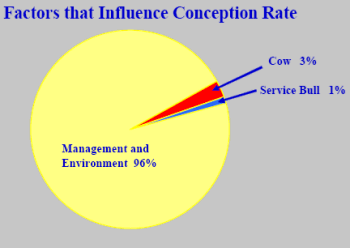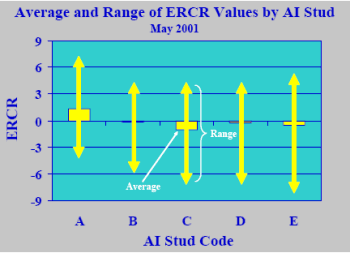



Proper use of ERCR Can Improve Conception Rates and Farm Profitability
Dr. Kent Weigel, Assistant Professor, Extension Genetics Specialist, University of Wisconsin, Genetic Programs Administrator, National Association of Animal Breeders. Fertility is a hot issue in the dairy industry today.Changes in herd management, coupled with higher milk production per cow and greater economic pressure on the farmer, have made ‘getting cows in calf’ a frequent topic of discussion at academic and industry meetings and at farmer gatherings.
Conception rates seem to be declining, but what is the cause? Many people are quick to blame genetics, and we’ll discuss this point in detail a bit later, but there are many other possibilities as well. Dairy farms are changing rapidly, and some of these changes lead to greater challenges in reproductive management. For example, herds are increasing in size at an astonishing rate. Common sense tells us that reproductive management is more difficult and time consuming with 500 cows than with 50 cows. Many duties, such as heat detection, that were previously handled by the owner-operator are now handled by hired employees who may not have much on-farm experience or training. Furthermore, changes in facilities may contribute to the problem. In many new dairies, cows are housed on concrete 24 hours a day, and this could certainly affect a cow’s tendency to express estrus symptoms.
What about the cow herself? Modern dairy cows continue to produce greater levels of milk each year, and without corresponding improvements in nutrition and cow comfort, these cows will experience significant stress. Fertility of virgin heifers has not declined over time, so it is easy to conclude that the stress associated with high milk production is the problem. However, many studies have shown that the herds with highest average milk production also have the best reproductive performance (presumably because they have the best management). Genetically speaking, we know there is a slight negative relationship between milk production and cow fertility. Bulls that sire daughters with high milk production, particularly bulls whose daughters tend to have poor body condition scores, will also tend to sire daughters with below average fertility. However, the magnitude of this relationship is small, and we know that it is possible to find many bulls that transmit high milk production and above average fertility.
The chart shown below describes the primary sources of variation in fertility. Management and environmental factors account for 96% of the variation in conception rates! Differences between herds due to factors such as nutrition and heat detection are huge. Climate differences, particularly high temperatures, also have a major impact on fertility. The cow’s genetic background accounts for only 3% of the variation in conception rate, and the service bull accounts for only 1%. So, genetic differences exist between animals, but it is very clear that the primary focus should be on improvement of management factors that influence fertility.

Suppose that you’ve already addressed issues such as herd health, nutrition, heat detection, and employee training, and you want to get a little extra “bump” in conception rate by selecting cows and service bulls with enhanced fertility.
National genetic evaluations for cow fertility (often called daughter fertility or female fertility) will not be available for another 12-18 months, so you’re out of luck for the moment. But service bull fertility (often called male fertility) is routinely evaluated by Dairy Records Management Systems (DRMS) in Raleigh, NC. In May and November of each year, this organization releases Estimated Relative Conception Rate (ERCR) information for hundreds of Holstein and Jersey bulls. These data can be accessed electronically by visiting http://www.drms.org.
The ERCR value for each bull can be interpreted as the 70 day non-return rate (i.e., presence or absence of a repeat breeding within 70 days) corresponding to inseminations by that bull relative to all other bulls that were used in the same herds. Environmental factors, such as herd, month of insemination, age of cow, days in milk, and milk production of the mate are taken into account. Only first services are used, and bulls must have at least 300 inseminations in the past three years to get a publishable ERCR evaluation.
Differences between service bulls are significant. A quick scan of the DRMS Raleigh web site shows that the poorest Holstein AI bulls are around -5% ERCR, and the best are never used ERCR before, so you’ve been using bulls that are, on average, about 0 for ERCR. You really want to improve the conception rate in your herd, so why not jump onto the ERCR bandwagon and breed the whole herd to the bull that’s +5%? Not so fast
Fertility is just one of several important traits we’d like to improve in our dairy cattle. There’s milk production, of course, but there are also other traits like type, somatic cell score, and productive life. Where does ERCR fit on the priority list? Virginia Tech research shows that, in an average herd, ERCR is worth about $2 per percentage point. For example, if you’re considering two bulls that are equivalent in genetic merit for all of the other important traits, you can assume that a straw of semen from the bull with +3% ERCR is worth $4 more than a straw from the bull with +1% ERCR. Yes, ERCR can be a useful trait to consider when purchasing semen, but like somatic cell score, productive life, and type, it is a secondary trait. You won’t get much benefit from using a bull with +5% ERCR if you give up $100 in Net Merit in the process.
What about selecting AI studs based on ERCR data of their bulls? Unlike the other traits in your selection program, service bull fertility can be influenced by the AI stud where the bull is housed. Differences in management of the bulls, handling of the semen, discarding of ejaculates, and other routine practices can have a slight effect on conception rates. However, differences between AI studs are extremely small when compared with differences between herds, seasons, and individual bulls within a stud. The following graph shows differences in average ERCR between studs, as well as the range in ERCR for individual bulls within each stud. All bulls owned by each of the major studs are included in the graph, not just bulls that are being actively marketed right now. As shown in the graph, the range in stud averages is about 2%, while the range in individual bulls within a stud is around 10%. Remember that using high ERCR bulls from any stud will increase conception rates but using below average ERCR bulls from high ranking studs will not.

In summary, let’s review several key points.
- Improvement of conception rate starts with good management. Cows need proper nutrition, as well as a clean, comfortable environment. Herd managers must make heat detection a priority, and effective training of every employee who is involved in the reproductive management program is essential.
- After these management issues have been addressed, additional gains in fertility may be possible by selection for cow fertility and service bull fertility.
- Service bull fertility, as measured by ERCR, is routinely available through DRMS.
- Differences between AI studs are small, but significant differences exist between individual bulls within a stud.
- Primary selection emphasis should focus on bulls that sire high lifetime profitability, as measured by Net Merit. Secondary selection for bulls with higher ERCR values can improve conception rates and increase farm profitability.


